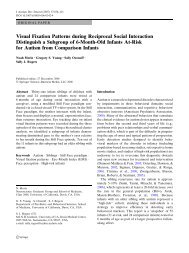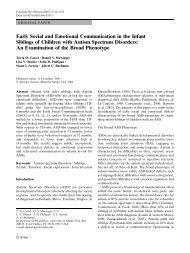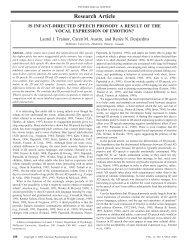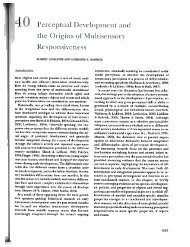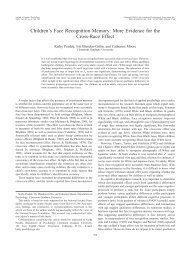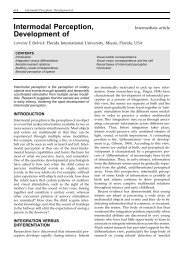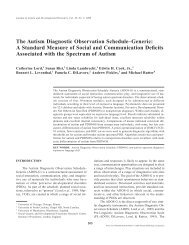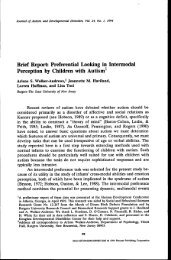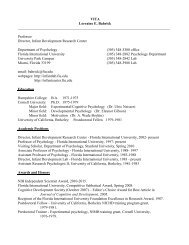The role of the mother's voice in developing mother's ... - FIU Infant Lab
The role of the mother's voice in developing mother's ... - FIU Infant Lab
The role of the mother's voice in developing mother's ... - FIU Infant Lab
Create successful ePaper yourself
Turn your PDF publications into a flip-book with our unique Google optimized e-Paper software.
32<br />
F. Z. Sai<br />
<strong>the</strong> mo<strong>the</strong>r’s face at birth. <strong>The</strong> <strong>in</strong>fants were, <strong>the</strong>refore, not exposed to <strong>the</strong>ir<br />
mo<strong>the</strong>r’s <strong>voice</strong> from birth through test<strong>in</strong>g.<br />
Some clarification <strong>of</strong> our understand<strong>in</strong>g <strong>of</strong> <strong>in</strong>fants’ learn<strong>in</strong>g about faces, and<br />
<strong>the</strong> <strong>role</strong> <strong>of</strong> <strong>the</strong> mo<strong>the</strong>r’s face <strong>in</strong> develop<strong>in</strong>g facial process<strong>in</strong>g is likely to emerge<br />
when newborn <strong>in</strong>fants are tested us<strong>in</strong>g <strong>the</strong> same procedures as <strong>in</strong> our previous<br />
studies (Sai, 1990; Bushnel et al., 1989), with a visual preference task and paired<br />
ra<strong>the</strong>r than sequential presentations <strong>of</strong> <strong>the</strong> comparison faces. This paper<br />
describes four studies which used non-Caucasian participants.<br />
EXPERIMENT 1<br />
<strong>The</strong> purpose <strong>of</strong> <strong>the</strong> present experiments was to determ<strong>in</strong>e <strong>the</strong> <strong>role</strong> <strong>of</strong> experience<br />
with <strong>the</strong> mo<strong>the</strong>r’s <strong>voice</strong> <strong>in</strong> facilitat<strong>in</strong>g face recognition <strong>in</strong> <strong>the</strong> neonatal period.<br />
However, s<strong>in</strong>ce our previous studies (Sai and Bushnell, 1987; Bushnell et al., 1989;<br />
Sai, 1990) demonstrat<strong>in</strong>g recognition <strong>of</strong> <strong>the</strong> mo<strong>the</strong>r’s face <strong>in</strong> <strong>the</strong> neonatal period<br />
tested only Caucasian neonates from <strong>the</strong> area <strong>of</strong> Glasgow, Scotland (UK), and <strong>the</strong><br />
participants <strong>in</strong> this research were Malaysians, it was seen advisable to first<br />
replicate <strong>the</strong>se earlier f<strong>in</strong>d<strong>in</strong>gs on Malaysian neonates.<br />
Before present<strong>in</strong>g details about <strong>the</strong> methodology and procedures followed <strong>in</strong><br />
<strong>the</strong>se experiments, it is worth po<strong>in</strong>t<strong>in</strong>g out that <strong>the</strong> newborn <strong>in</strong>fants were<br />
reta<strong>in</strong>ed on <strong>the</strong> ward at all times, <strong>in</strong> bass<strong>in</strong>ets located adjacent to <strong>the</strong>ir mo<strong>the</strong>r’s<br />
bed. <strong>The</strong> mo<strong>the</strong>rs had cont<strong>in</strong>uous responsibility for <strong>the</strong> care <strong>of</strong> <strong>the</strong>ir <strong>in</strong>fants.<br />
Although <strong>the</strong> total <strong>in</strong>teractive contact hours <strong>in</strong>volved with<strong>in</strong> each mo<strong>the</strong>r–<strong>in</strong>fant<br />
dyad was not assessed, some provisional observations (Sai, 1990) showed that<br />
<strong>the</strong>re was a fairly substantial period <strong>of</strong> contact with<strong>in</strong> <strong>the</strong> first 24 h. However,<br />
<strong>the</strong>re was a considerable variability across dyads.<br />
S<strong>in</strong>ce our earlier f<strong>in</strong>d<strong>in</strong>gs had <strong>in</strong>dicated no significant relationship between age<br />
and extent <strong>of</strong> preference, age was not considered as a potential factor, and was<br />
<strong>the</strong>refore not <strong>in</strong>cluded. Similarly, sex factor was not <strong>in</strong>corporated for <strong>the</strong> same<br />
reason (see Sai, 1990).<br />
Method<br />
Participants<br />
Fourteen newborn <strong>in</strong>fants, seven males and seven females (M ¼ 3:00 h,<br />
range ¼ 224h;M birth weight ¼ 2:75 kg, range ¼ 2:7022:90) participated <strong>in</strong> this<br />
study. <strong>The</strong>y all had normal Apgar scores after 5 m<strong>in</strong> (M ¼ 9, range ¼ 8210), and<br />
throughout test<strong>in</strong>g <strong>the</strong>y rema<strong>in</strong>ed <strong>in</strong> <strong>the</strong> behavioural state <strong>of</strong> alert <strong>in</strong>activity<br />
(Ashton, 1973). All <strong>the</strong> <strong>in</strong>fants <strong>in</strong> this and subsequent studies were normal,<br />
healthy and full-term <strong>in</strong>fants (37 weeks gestation) with no complications dur<strong>in</strong>g<br />
delivery. <strong>The</strong> <strong>in</strong>fants were primarily from middle class and diverse ethnic<br />
backgrounds <strong>of</strong> Malaysia (Malay, Ch<strong>in</strong>ese and H<strong>in</strong>dou). <strong>The</strong>y were volunteered<br />
by <strong>the</strong>ir mo<strong>the</strong>rs on <strong>the</strong> wards <strong>of</strong> <strong>the</strong> University Hospital, Kuala Lumpur where<br />
<strong>the</strong>y were born. <strong>The</strong> data <strong>of</strong> ten additional <strong>in</strong>fants were discarded from <strong>the</strong> study:<br />
four for side bias <strong>in</strong> <strong>the</strong>ir look<strong>in</strong>g behaviour (see procedure section for details<br />
regard<strong>in</strong>g criteria for side bias), three for excessive fuss<strong>in</strong>ess, two for persistent<br />
sleep<strong>in</strong>g and one because <strong>the</strong> mo<strong>the</strong>r made sounds dur<strong>in</strong>g <strong>the</strong> test<strong>in</strong>g.<br />
Stimuli and Apparatus<br />
<strong>The</strong> stimulus faces for each participant <strong>in</strong> this experiment were <strong>the</strong> live face <strong>of</strong><br />
<strong>the</strong> participant’s mo<strong>the</strong>r and that <strong>of</strong> a female stranger. This was ano<strong>the</strong>r mo<strong>the</strong>r<br />
Copyright # 2004 John Wiley & Sons, Ltd. Inf. Child Dev. 14: 29–50 (2005)



